Exploring Intermetallic Compounds: Properties and Applications in Catalysis
Abstract
:1. Introduction
2. Advantages of IMCs in Catalysis
3. Synthesis Methods of IMCs
3.1. Solid-State Synthesis
3.2. Solution-Based Synthesis
3.2.1. Chemical Reduction Method
3.2.2. Annealing Reduction Method
3.3. Vapor-Phase Synthesis
4. Catalytic Applications of IMCs
4.1. Oxidative Reaction
4.2. Hydrogenation Catalysis
4.2.1. Hydrogenation of Multiple Bonds
4.2.2. Semi-Hydrogenation
4.2.3. Selective Hydrogenation
4.2.4. Hydroformylation
4.2.5. Selective Hydrogenation of Unsaturated Aldehydes
4.3. Electrocatalysis
4.3.1. HER Electrocatalysis
4.3.2. Oxygen Reduction Reaction (ORR)
4.3.3. Oxygen Evolution Reaction (OER)
4.4. Carbon–Carbon Coupling Reactions
4.5. Other Catalytic Applications
4.5.1. Steam Reforming
4.5.2. Reverse Water Gas Shift Reaction
4.5.3. Propane Dehydrogenation
5. Conclusions and Perspectives
Author Contributions
Funding
Data Availability Statement
Conflicts of Interest
References
- Gao, R.Y.; Tian, X.R.; Ding, X.L.; Hou, Z.Q.; Li, Z.Y.; Yu, X.H.; Wang, J.; Wu, L.K.; Jing, L.; Deng, J.G.; et al. Regulating catalytic stability of PtSnM/CeO2 (M = Mn, W, Nb) catalysts via the closely coupled multi-active sites to promote multicomponent VOCs oxidation. Chem. Eng. J. 2023, 471, 144456. [Google Scholar] [CrossRef]
- Lin, F.W.; Zhang, Z.M.; Li, N.; Yan, B.B.; He, C.; Hao, Z.P.; Chen, G.Y. How to achieve complete elimination of Cl-VOCs: A critical review on byproducts formation and inhibition strategies during catalytic oxidation. Chem. Eng. J. 2021, 404, 126534. [Google Scholar] [CrossRef]
- Xing, F.L.; Ma, J.M.; Shimizu, K.; Furukawa, S. High-entropy intermetallics on ceria as efficient catalysts for the oxidative dehydrogenation of propane using CO2. Nat. Commun. 2022, 13, 5065. [Google Scholar] [CrossRef]
- Sharma, H.R.; Shimoda, M.; Tsai, A.P. Quasicrystal surfaces: Structure and growth of atomic overlayers. Adv. Phys. 2007, 56, 403–464. [Google Scholar] [CrossRef]
- Feng, S.M.; Geng, Y.Y.; Liu, H.Y.; Li, H. Targeted intermetallic nanocatalysts for sustainable biomass and CO2 valorization. ACS Catal. 2022, 12, 14999–15020. [Google Scholar] [CrossRef]
- Wang, Y.F.; Sun, D.; Chowdhury, T.; Wagner, J.S.; Kempa, T.J.; Hall, A.S. Rapid room-temperature synthesis of a metastable ordered intermetallic electrocatalyst. J. Am. Chem. Soc. 2019, 141, 2342–2347. [Google Scholar] [CrossRef]
- George, E.P.; Raabe, D.; Ritchie, R.O. High-entropy alloys. Nat. Rev. Mater. 2019, 4, 515–534. [Google Scholar] [CrossRef]
- Kim, S.H.; Kim, H.; Kim, N.J. Brittle intermetallic compound makes ultrastrong low-density steel with large ductility. Nature 2015, 518, 77–79. [Google Scholar] [CrossRef]
- Gschneidner Jr, K.; Russell, A.; Pecharsky, A.; Morris, J.; Zhang, Z.H.; Lograsso, T.; Hsu, D.; Chester Lo, C.H.; Ye, Y.Y.; Slager, A.; et al. A family of ductile intermetallic compounds. Nat. Mater. 2003, 2, 587–591. [Google Scholar] [CrossRef] [PubMed]
- Yang, Y.S.; Wei, M. intermetallic compound catalysts: Synthetic scheme, structure characterization and catalytic application. J. Mater. Chem. A. 2020, 8, 2207–2221. [Google Scholar] [CrossRef]
- Furukawa, S.; Komatsu, T. intermetallic compounds: Promising inorganic materials for well-structured and electronically modified reaction environments for efficient catalysis. ACS Catal. 2017, 7, 735–765. [Google Scholar] [CrossRef]
- Zhang, J.M.; Shen, L.F.; Jiang, Y.X.; Sun, S.G. Random alloy and intermetallic nanocatalysts in fuel cell reactions. Nanoscale 2020, 12, 19557–19581. [Google Scholar] [CrossRef]
- Liu, C.; Lu, W.J.; Xia, W.Z.; Du, C.W.; Rao, Z.Y.; Best, J.P.; Brinckmann, S.; Lu, J.; Gault, B.; Dehm, G.; et al. Massive interstitial solid solution alloys achieve near-theoretical strength. Nat. Commun. 2022, 13, 1102. [Google Scholar] [CrossRef] [PubMed]
- Wang, D.; Xie, Z.; Yao, B.D.; Si, J.X.; Wu, L.; Wu, X.Y.; Wang, Y.X. Theoretical investigation on solid solution effect in dilute Zr alloys: Insight into mechanical and thermal properties. J. Mater. Res. Technol. 2024, 29, 738–750. [Google Scholar] [CrossRef]
- Voznyaka, I.; Tokaychuka, Y.; Hlukhyyb, V.; Fässlerb, T.F.; Gladyshevskiia, R. Interstitial solid solution Hf5GaxSn3 (x = 0–1). J. Alloys Compd. 2012, 512, 246–251. [Google Scholar] [CrossRef]
- Xin, J.Z.; Zhang, Y.; Wu, H.J.; Zhu, T.J.; Fu, T.Z.; Shen, J.J.; Pennycook, S.J.; Zhao, X.B. Multiscale defects as strong phonon scatters to enhance thermoelectric performance in Mg2Sn1–xSbx solid solutions. Small Methods 2019, 3, 1900412. [Google Scholar] [CrossRef]
- Zhang, L.; Li, H.G.; Bai, H.Y.; Ning, Z.L.; Sun, J.F.; Huang, Y.J. Rationality of two-phase coexistence with no element segregation in a CuZr-based amorphous alloy composite. J. Alloys Compd. 2023, 962, 171185. [Google Scholar] [CrossRef]
- Williams, B.P.; Qi, Z.Y.; Huang, W.Y.; Tsung, C.K. The impact of synthetic method on the catalytic application of intermetallic nanoparticles. Nanoscale 2020, 12, 18545–18562. [Google Scholar] [CrossRef] [PubMed]
- Armbrüster, M.; Kovnir, K.; Friedrich, M.; Teschner, D.; Wowsnick, G.; Hahne, M.; Gille, P.; Szentmiklósi, L.; Feuerbacher, M.; Heggen, M.; et al. Al13Fe4 as a low-cost alternative for palladium in heterogeneous hydrogenation. Nat. Mater. 2012, 11, 690–693. [Google Scholar] [CrossRef]
- De Smit, E.; Weckhuysen, B.M. The renaissance of iron-based Fischer―Tropsch synthesis: On the multifaceted catalyst deactivation behaviour. Chem. Soc. Rev. 2008, 37, 2758–2781. [Google Scholar] [CrossRef]
- Armbrüster, M.; Kovnir, K.; Behrens, M.; Teschner, D.; Grin, Y.; Schlögl, R. Pd―Ga intermetallic compounds as highly selective semi-hydrogenation catalysts. J. Am. Chem. Soc. 2010, 132, 14745–14747. [Google Scholar] [CrossRef] [PubMed]
- Han, A.J.; Zhang, J.; Sun, W.M.; Chen, W.X.; Zhang, S.L.; Han, Y.H.; Feng, Q.C.; Zheng, L.R.; Gu, L.; Chen, C.; et al. Isolating contiguous Pt atoms and forming Pt-Zn intermetallic nanoparticles to regulate selectivity in 4-nitrophenylacetylene hydrogenation. Nat. Commun. 2019, 10, 3787. [Google Scholar] [CrossRef] [PubMed]
- Wang, Y.Z.; Lv, H.; Sun, L.Z.; Jia, F.R.; Liu, B. Ordered mesoporous intermetallic trimetals for efficient and pH-universal hydrogen evolution electrocatalysis. Adv. Energy Mater. 2022, 12, 2201478. [Google Scholar] [CrossRef]
- Yin, P.; Niu, X.F.; Li, S.B.; Chen, K.; Zhang, X.; Zuo, M.; Zhang, L.; Liang, H.W. Machine-learning-accelerated design of high-performance platinum intermetallic nanoparticle fuel cell catalysts. Nat. Commun. 2024, 15, 415. [Google Scholar] [CrossRef]
- Studt, F.; Sharafutdinov, I.; Abild-Pedersen, F.; Elkjær, C.F.; Hummelshøj, J.S.; Dahl, S.; Chorkendorff, I.; Nørskov, J.K. Discovery of a Ni–Ga catalyst for carbon dioxide reduction to methanol. Nat. Chem. 2014, 6, 320–324. [Google Scholar] [CrossRef]
- Ji, Y.L.; Chen, Z.; Wei, R.L.; Yang, C.; Wang, Y.H.; Xu, J.; Zhang, H.; Guan, A.X.; Chen, J.T.; Sham, T.K.; et al. Selective CO-to-acetate electroproduction via intermediate adsorption tuning on ordered Cu–Pd sites. Nat. Catal. 2022, 5, 251–258. [Google Scholar] [CrossRef]
- Lv, H.; Wang, Y.Z.; Sun, L.Z.; Yamauchi, Y.; Liu, B. A general protocol for precise syntheses of ordered mesoporous intermetallic nanoparticles. Nat. Protoc. 2023, 18, 3126–3154. [Google Scholar] [CrossRef]
- Feng, G.; An, L.; Li, B.; Zuo, Y.X.; Song, J.; Ning, F.H.; Jiang, N.; Cheng, X.P.; Zhang, Y.F.; Xia, D.G. Atomically ordered non-precious Co3Ta intermetallic nanoparticles as high-performance catalysts for hydrazine electrooxidation. Nat. Commun. 2019, 10, 4514. [Google Scholar] [CrossRef]
- Han, S.W.; Park, H.; Han, J.; Kim, J.C.; Lee, J.; Jo, C.; Ryoo, R. PtZn intermetallic compound nanoparticles in mesoporous zeolite exhibiting high catalyst durability for propane dehydrogenation. ACS Catal. 2021, 11, 9233–9241. [Google Scholar] [CrossRef]
- Hou, Z.Q.; Liu, Y.X.; Deng, J.G.; Lu, Y.; Xie, S.H.; Fang, X.Z.; Dai, H.X. Highly active and stable Pd–GaOx/Al2O3 catalysts derived from intermetallic Pd5Ga3 nanocrystals for methane combustion. ChemCatChem 2018, 10, 5637–5648. [Google Scholar] [CrossRef]
- Shan, S.Y.; Li, J.; Maswadeh, Y.; O’Brien, C.; Kareem, H.; Tran, D.T.; Lee, I.C.; Wu, Z.P.; Wang, S.; Yan, S.; et al. Surface oxygenation of multicomponent nanoparticles toward active and stable oxidation catalysts. Nat. Commun. 2020, 11, 4201. [Google Scholar] [CrossRef] [PubMed]
- Gao, Q.; Yao, B.Q.; Pillai, H.S.; Zang, W.J.; Han, X.; Liu, Y.Q.; Yu, S.W.; Yan, Z.H.; Min, B.; Zhang, S.; et al. Synthesis of core/shell nanocrystals with ordered intermetallic single-atom alloy layers for nitrate electroreduction to ammonia. Nat. Synth. 2023, 2, 624–634. [Google Scholar] [CrossRef]
- Guo, M.; Ma, P.J.; Wei, L.; Wang, J.Y.; Wang, Z.W.; Zheng, K.; Cheng, D.J.; Liu, Y.X.; Dai, H.X.; Guo, G.S.; et al. Highly selective activation of C–H bond and inhibition of C–C bond cleavage by tuning strong oxidative Pd sites. J. Am. Chem. Soc. 2023, 145, 11110–11120. [Google Scholar] [CrossRef] [PubMed]
- Guo, M.; Ma, P.J.; Wang, J.Y.; Xu, H.X.; Zheng, K.; Cheng, D.J.; Liu, Y.X.; Guo, G.S.; Dai, H.X.; Duan, E.H.; et al. Synergy in Au-CuO janus structure for catalytic isopropanol oxidative dehydrogenation to acetone. Angew. Chem. Int. Ed. 2022, 61, e202203827. [Google Scholar] [CrossRef] [PubMed]
- Gao, R.Y.; Zhang, M.C.; Liu, Y.X.; Xie, S.H.; Deng, J.G.; Ke, X.X.; Jing, L.; Hou, Z.Q.; Zhang, X.; Liu, F.D.; et al. Engineering platinum catalysts via a site-isolation strategy with enhanced chlorine resistance for the elimination of multicomponent VOCs. Environ. Sci. Technol. 2022, 56, 9672–9682. [Google Scholar] [CrossRef] [PubMed]
- Mondal, S.; Bagchi, D.; Riyaz, M.; Sarkar, S.; Singh, A.K.; Vinod, C.P.; Peter, S.C. In situ mechanistic insights for the oxygen reduction reaction in chemically modulated ordered intermetallic catalyst promoting complete electron transfer. J. Am. Chem. Soc. 2022, 144, 11859–11869. [Google Scholar] [CrossRef] [PubMed]
- Cesar, L.G.; Yang, C.; Lu, Z.; Ren, Y.; Zhang, G.H.; Miller, J.T. Identification of a Pt3Co surface intermetallic alloy in Pt–Co propane dehydrogenation catalysts. ACS Catal. 2019, 9, 5231–5244. [Google Scholar] [CrossRef]
- Ratschmeier, B.; Paulsen, C.; Stallberg, K.; Roß, G.; Daum, W.; Pöttgen, R.; Braunschweig, B. Cu/Au(111) surfaces and AuCu intermetallics for electrocatalytic reduction of CO2 in ionic liquid electrolytes. ACS Catal. 2024, 14, 1773–1784. [Google Scholar] [CrossRef]
- Onda, A.; Komatsu, T.; Yashima, T. Characterization and catalytic properties of Ni–Sn intermetallic compounds in acetylene hydrogenation. Phys. Chem. Chem. Phys. 2000, 2, 2999–3005. [Google Scholar] [CrossRef]
- Endo, N.; Ito, S.; Tomishige, K.; Kameoka, S.; Tsai, A.P.; Hirata, T.; Nishimura, C. CO hydrogenation over a hydrogen-induced amorphization of intermetallic compound CeNi2. Catal. Today 2011, 164, 293–296. [Google Scholar] [CrossRef]
- Endo, N.; Kameoka, S.; Tsai, A.P.; Lingling, Z.; Hirata, T.; Nishimura, C. Hydrogen absorption properties of intermetallic compounds in the Au–Zr binary system. J. Alloys Compd. 2009, 485, 588–592. [Google Scholar] [CrossRef]
- Zou, P.F.; Zheng, C.H.; Hu, L.; Wang, H.P. Rapid growth of TiNi intermetallic compound within undercooled Ti50Ni50 alloy under electrostatic levitation condition. J. Mater. Sci. Technol. 2021, 77, 82–89. [Google Scholar] [CrossRef]
- Zhao, J.J.; Wu, C.S.; Shi, L.; Su, H. Evolution of microstructures and intermetallic compounds at bonding interface in friction stir welding of dissimilar Al/Mg alloys with/without ultrasonic assistance. J. Mater. Sci. Technol. 2023, 139, 31–46. [Google Scholar] [CrossRef]
- Ma, H.; Qin, G.L.; Geng, P.H.; Ao, Z.Y.; Chen, Y. Effect of intermetallic compounds on the mechanical property and corrosion behavior of aluminum alloy/steel hybrid fusion-brazed welded structure. J. Manuf. Process 2022, 75, 170–180. [Google Scholar] [CrossRef]
- Zhao, B.K.; Zhang, Q.H.; Fu, X.Q.; Qiao, D.X.; Zhang, L.; Chen, X.; Gu, L.; Lu, Y.P.; Yu, Q. Brittle-to-ductile transition in Ti–Pt intermetallic compounds Beikai. Sci. Bull. 2021, 66, 2281–2287. [Google Scholar] [CrossRef] [PubMed]
- Zeng, W.J.; Wang, C.; Yan, Q.Q.; Yin, P.; Tong, L.; Liang, H.W. Phase diagrams guide synthesis of highly ordered intermetallic electrocatalysts: Separating alloying and ordering stages. Nat. Commun. 2022, 13, 7654. [Google Scholar] [CrossRef]
- Gao, M.; Chen, T.J. Formation of intermetallic compounds during reaction between Ti and Al–Mg alloys with various Mg contents. J. Mater. Sci. Technol. 2023, 159, 225–243. [Google Scholar] [CrossRef]
- Kang, J.; Lee, J.I.; Choi, S.; Choi, Y.; Park, S.; Ryu, J. Nonporous oxide-terminated multicomponent bulk anode enabling energy-dense sodium-ion batteries. ACS Appl. Mater. Interfaces 2023, 15, 26576–26584. [Google Scholar] [CrossRef]
- Gong, M.X.; Shen, T.; Deng, Z.P.; Yang, H.Y.; Li, Z.R.; Zhang, J.J.; Zhang, R.; Hu, Y.Z.; Zhao, X.; Xin, H.L.; et al. Surface engineering of PdFe ordered intermetallics for efficient oxygen reduction electrocatalysis. Chem. Eng. J. 2021, 408, 127297. [Google Scholar] [CrossRef]
- Song, R.R.; Han, J.H.; Okugawa, M.; Belosludov, R.; Wada, T.; Jiang, J.; Wei, D.X.; Kudo, A.; Tian, Y.; Chen, M.W.; et al. Ultrafine nanoporous intermetallic catalysts by high-temperature liquid metal dealloying for electrochemical hydrogen production. Nat. Commun. 2022, 13, 5157. [Google Scholar] [CrossRef] [PubMed]
- Cui, M.J.; Yang, C.P.; Hwang, S.; Yang, M.H.; Overa, S.; Dong, Q.; Yao, Y.G.; Brozena, A.H.; Cullen, D.A.; Chi, M.F.; et al. Multi-principal elemental intermetallic nanoparticles synthesized via a disorder-to-order transition. Sci. Adv. 2022, 8, eabm4322. [Google Scholar] [CrossRef] [PubMed]
- Burda, C.; Chen, X.B.; Narayanan, R.; El-Sayed, M.A. Chemistry and properties of nanocrystals of different shapes. Chem. Rev. 2005, 105, 1025–1102. [Google Scholar] [CrossRef] [PubMed]
- Rao, C.N.R.; Kulkarni, G.U.; Thomas, P.J.; Edwards, P.P. Metal nanoparticles and their assemblies. Chem. Soc. Rev. 2000, 29, 27–35. [Google Scholar] [CrossRef]
- Xue, J.N.; Hu, Z.; Li, H.; Zhang, Y.; Liu, C.; Li, M.; Yang, Q.H.; Hu, S. Pd-Sn alloy nanoparticles for electrocatalytic methanol oxidation: Phase evolution from solid solution to intermetallic compounds. Nano Res. 2022, 15, 8819–8825. [Google Scholar] [CrossRef]
- Li, F.; Zong, Y.; Ma, Y.L.; Wang, M.X.; Shang, W.; Tao, P.; Song, C.Y.; Deng, T.; Zhu, H.; Wu, J.B. Atomistic imaging of competition between surface diffusion and phase transition during the intermetallic formation of faceted particles. ACS Nano 2021, 15, 5284–5293. [Google Scholar] [CrossRef] [PubMed]
- Chou, N.H.; Schaak, R. Shape-controlled conversion of β-Sn nanocrystals into intermetallic M–Sn (M = Fe, Co, Ni, Pd) nanocrystals. J. Am. Chem. Soc. 2007, 129, 7339–7345. [Google Scholar] [CrossRef] [PubMed]
- Sra, A.K.; Schaak, R.E. Synthesis of atomically ordered AuCu and AuCu3 nanocrystals from bimetallic nanoparticle precursors. J. Am. Chem. Soc. 2004, 126, 6667–6672. [Google Scholar] [CrossRef] [PubMed]
- Li, Y.D.; Li, L.Q.; Liao, H.W.; Wang, H.R. Preparation of pure nickel, cobalt, nickel–cobalt and nickel–copper alloys by hydrothermal reduction. J. Mater. Chem. 1999, 9, 2675–2677. [Google Scholar] [CrossRef]
- Heise, M.; Chang, J.H.; Schönemann, R.; Herrmannsdörfer, T.; Wosnitza, J.; Ruck, M. Full access to nanoscale bismuth–palladium intermetallics by low-temperature syntheses. Chem. Mater. 2014, 26, 5640–5646. [Google Scholar] [CrossRef]
- Li, C.C.; Sun, L.; Sun, Y.Q.; Teranishi, T. One-pot controllable synthesis of Au@Ag heterogeneous nanorods with highly tunable plasmonic absorption. Chem. Mater. 2013, 25, 2580–2590. [Google Scholar] [CrossRef]
- Chen, Y.Y.; Lin, H.; Huo, J.L.; Ma, T.M.; Du, L. Multi-scale exploring the output performance mechanism in MEA with high intrinsic activity PtCo intermetallic compounds. J. Clean. Prod. 2024, 434, 140072. [Google Scholar] [CrossRef]
- Song, T.W.; Chen, M.X.; Yin, P.; Tong, L.; Zuo, M.; Chu, S.Q.; Chen, P.; Liang, H.W. Intermetallic PtFe electrocatalysts for the oxygen reduction reaction: Ordering degree-dependent performance. Small 2022, 18, 2202916. [Google Scholar] [CrossRef]
- Wang, X.X.; Hwang, S.; Pan, Y.T.; Chen, K.; He, Y.H.; Karakalos, S.; Zhang, H.G.; Spendelow, J.S.; Su, D.; Wu, G. Ordered Pt3Co intermetallic nanoparticles derived from metal–organic frameworks for oxygen reduction. Nano Lett. 2018, 18, 4163–4171. [Google Scholar] [CrossRef] [PubMed]
- Stassi, J.P.; Zgolicz, P.D.; Miguel, S.R.; Scelza, S.O. Formation of different promoted metallic phases in PtFe and PtSn catalysts supported on carbonaceous materials used for selective hydrogenation. J. Catal. 2013, 306, 11–29. [Google Scholar] [CrossRef]
- Furukawa, S.; Ehara, K.; Komatsu, T. Unique reaction mechanism of preferential oxidation of CO over intermetallic Pt3Co catalysts: Surface-OH-mediated formation of a bicarbonate intermediate. Catal. Sci. Technol. 2016, 6, 1642–1650. [Google Scholar] [CrossRef]
- Komatsu, T.; Takasaki, M.; Ozawa, K.; Furukawa, S.; Muramatsu, A. PtCu intermetallic compound supported on alumina active for preferential oxidation of CO in hydrogen. J. Phys. Chem. C 2013, 117, 10483–10491. [Google Scholar] [CrossRef]
- Furukawa, S.; Endo, M.; Komatsu, T. Bifunctional catalytic system effective for oxidative dehydrogenation of 1-butene and n-butane using Pd-based intermetallic compounds. ACS Catal. 2014, 4, 3533–3542. [Google Scholar] [CrossRef]
- Yang, C.L.; Wang, L.N.; Yin, P.; Liu, J.Y.; Chen, M.X.; Yan, Q.Q.; Wang, Z.S.; Xu, S.L.; Chu, S.Q.; Cui, C.H.; et al. Sulfur-anchoring synthesis of platinum intermetallic nanoparticle catalysts for fuel cells. Science 2021, 374, 459–464. [Google Scholar] [CrossRef]
- Hu, M.Z.; Zhao, S.; Liu, S.J.; Chen, C.; Chen, W.X.; Zhu, W.; Liang, C.; Cheong, W.C.; Wang, Y.; Yu, Y.; et al. MOF-confined sub-2 nm atomically ordered intermetallic PdZn nanoparticles as high-performance catalysts for selective hydrogenation of acetylene. Adv. Mater. 2018, 30, 1801878. [Google Scholar] [CrossRef]
- Ota, A.; Kunkes, E.L.; Kasatkin, I.; Groppo, E.; Ferri, D.; Poceiro, B.; Yerga, R.M.N.; Behrens, M. Comparative study of hydrotalcite-derived supported Pd2Ga and PdZn intermetallic nanoparticles as methanol synthesis and methanol steam reforming catalysts. J. Catal. 2012, 293, 27–38. [Google Scholar] [CrossRef]
- Gunji, T.; Tanabe, T.; Jeevagan, A.J.; Usui, S.; Tsuda, T.; Kaneko, S.; Saravanan, G.; Abe, H.; Matsumoto, F. Facile route for the preparation of ordered intermetallic Pt3P–PtPb core-shell nanoparticles and its enhanced activity for alkaline methanol and ethanol oxidation. J. Power Sources 2015, 273, 990–998. [Google Scholar] [CrossRef]
- Zhou, F.Y.; Ruan, Y.E.; Zhu, M.Z.; Gao, X.P.; Guo, W.X.; Liu, X.K.; Wang, W.Y.; Chen, M.; Wu, G.; Yao, T.; et al. Coupling single-atom sites and ordered intermetallic PtM nanoparticles for efficient catalysis in fuel cells. Small 2023, 19, 2302328. [Google Scholar] [CrossRef]
- Chen, X.; Li, M.; Guan, J.C.; Wang, X.K.; Williams, C.T.; Liang, C.H. Nickel-silicon intermetallics with enhanced selectivity in hydrogenation reactions of cinnamaldehyde and phenylacetylene. Ind. Eng. Chem. Res. 2012, 51, 3604–3611. [Google Scholar] [CrossRef]
- Komatsu, T.; Tamura, A. Pt3Co and PtCu intermetallic compounds: Promising catalysts for preferential oxidation of CO in excess hydrogen. J. Catal. 2008, 258, 306–314. [Google Scholar] [CrossRef]
- Komatsu, T.; Sou, K.; Ozawa, K. Preparation and catalytic properties of fine particles of Pt–Ge intermetallic compound formed inside the mesopores of MCM-41. J. Mol. Catal. A 2010, 319, 71–77. [Google Scholar] [CrossRef]
- Terada, T.; Kitaura, R.; Ishigaki, S.; Ishibe, T.; Naruse, N.; Mera, Y.; Asahi, R.; Nakamura, Y. Seed-assisted epitaxy of intermetallic compounds with interface-determined orientation: Incommensurate Nowotny chimney-ladder FeGeγ epitaxial film. Acta Mater. 2022, 236, 118130. [Google Scholar] [CrossRef]
- Santra, A.K.; Goodman, D.W. Catalytic oxidation of CO by platinum group metals: From ultrahigh vacuum to elevated pressures. Electrochim. Acta 2002, 47, 3595–3609. [Google Scholar] [CrossRef]
- Over, H.; Muhler, M. Catalytic CO oxidation over ruthenium-bridging the pressure gap. Prog. Surf. Sci. 2003, 72, 3–17. [Google Scholar] [CrossRef]
- Min, B.K.; Friend, C.M. Heterogeneous gold-based catalysis for green chemistry: Low-temperature CO oxidation and propene oxidation. Chem. Rev. 2007, 107, 2709–2724. [Google Scholar] [CrossRef]
- Freund, H.J.; Meijer, G.; Scheffler, M.; Schlögl, R.; Wolf, M. CO oxidation as a prototypical reaction for heterogeneous processes. Angew. Chem. Int. Ed. 2011, 50, 10064–10094. [Google Scholar] [CrossRef]
- Saravanan, G.; Abe, H.; Xu, Y.; Sekido, N.; Hirata, H.; Matsumoto, S.I.; Yoshikawa, H.; Yamabe-Mitarai, Y. Pt3Ti nanoparticles: Fine dispersion on SiO2 supports, enhanced catalytic CO oxidation, and chemical stability at elevated temperatures. Langmuir 2010, 26, 11446–11451. [Google Scholar] [CrossRef]
- Liu, X.Y.; Wang, A.Q.; Li, L.; Zhang, T.; Mou, C.Y.; Lee, J.F. Structural changes of Au-Cu bimetallic catalysts in CO oxidation: In situ XRD, EPR, XANES, and FT-IR characterizations. J. Catal. 2011, 278, 288–296. [Google Scholar] [CrossRef]
- Xiao, C.X.; Wang, L.L.; Maligal-Ganesh, R.V.; Smetana, V.; Walen, H.; Thiel, P.A.; Miller, G.J.; Johnson, D.D.; Huang, W.Y. Intermetallic NaAu2 as a heterogeneous catalyst for low-temperature CO oxidation. J. Am. Chem. Soc. 2013, 135, 9592–9595. [Google Scholar] [CrossRef] [PubMed]
- Wang, J.; Dai, L.Y.; Deng, J.G.; Liu, Y.X.; Jing, L.; Pei, W.B.; Hou, Z.Q.; Zhang, X.; Yu, X.H.; Dai, H.X. Experimental and density functional theory investigations on the oxidation of typical aromatics over the intermetallic compounds-derived AuMn/meso-Fe2O3 catalysts. J. Catal. 2022, 405, 273–287. [Google Scholar] [CrossRef]
- Wang, J.; Dai, L.Y.; Deng, J.G.; Liu, Y.X.; Jing, L.; Hao, X.Q.; Pei, W.B.; Yu, X.H.; Rastegarpanah, A.; Dai, H.X. An investigation on catalytic performance and reaction mechanism of RuMn/meso-TiO2 derived from RuMn intermetallic compounds for methyl ethyl ketone oxidation. Appl. Catal. B 2021, 296, 120361. [Google Scholar] [CrossRef]
- Li, X.; Liu, Y.M.; Zhang, J.J.; Yan, B.; Jin, C.Q.; Dou, J.J.; Li, M.Y.; Feng, X.H.; Liu, G. No annealing synthesis of ordered intermetallic PdCu nanocatalysts for boosting formic acid oxidation. Chem. Mater. 2022, 34, 1385–1391. [Google Scholar] [CrossRef]
- Baglin, E.G.; Atkinson, G.B.; Nicks, L.J. Methanol synthesis catalysts from thorium-copper intermetallics. Preparation and evaluation. Ind. Eng. Chem. Prod. Res. Dev. 1981, 20, 87–90. [Google Scholar] [CrossRef]
- Ferreira, A.C.; Goncalves, A.P.; Gasche, T.A.; Ferraria, A.M.; Rego, A.M.B.D.; Correia, M.R.; Bola, A.M.; Branco, J.B. Partial oxidation of methane over bimetallic copper-and nickel-actinide oxides (Th, U). J. Alloys Compd. 2010, 497, 249–258. [Google Scholar] [CrossRef]
- Sasikala, R.; Gupta, N.M.; Kulshreshtha, S.K.; Iyer, R.M. Carbon monoxide methanation over FeTi1+ x intermetallics. J. Catal. 1987, 107, 510–521. [Google Scholar] [CrossRef]
- Chen, X.; Jin, J.H.; Sha, G.Y.; Li, C.; Zhang, B.S.; Su, D.S.; Williams, C.T.; Liang, C.H. Silicon-nickel intermetallic compounds supported on silica as a highly efficient catalyst for CO methanation. Catal. Sci. Technol. 2014, 4, 53–61. [Google Scholar] [CrossRef]
- Ye, C.L.; Chen, X.J.; Li, S.S.; Feng, B.B.; Fu, Y.H.; Zhang, F.M.; Chen, D.L.; Zhu, W.D. PdZn intermetallic compound stabilized on ZnO/nitrogen-decorated carbon hollow spheres for catalytic semihydrogenation of alkynols. Nano Res. 2022, 15, 3090–3098. [Google Scholar] [CrossRef]
- Almisbaa, Z.; Aljama, H.A.; Almajnouni, K.; Cavallo, L.; Sautet, P. Acetylene semi-hydrogenation on intermetallic Ni–In catalysts: Ni ensemble and acetylene coverage effects from a theoretical analysis. ACS Catal. 2023, 13, 7358–7370. [Google Scholar] [CrossRef]
- Armbrüster, M.; Wowsnick, G.; Friedrich, M.; Heggen, M.; Cardoso-Gil, R. Synthesis and catalytic properties of nanoparticulate intermetallic Ga-Pd compounds. J. Am. Chem. Soc. 2011, 133, 9112. [Google Scholar] [CrossRef]
- Shao, L.D.; Zhang, W.; Armbrüster, M.; Teschner, D.; Girgsdies, F.; Zhang, B.; Timpe, O.; Friedrich, M.; Schlögl, R.; Su, D.S. Nanosizing intermetallic compounds onto carbon nanotubes: Active and selective hydrogenation catalysts. Angew. Chem. Int. Ed. 2011, 50, 10231–10235. [Google Scholar] [CrossRef]
- Zhou, H.R.; Yang, X.F.; Li, L.; Liu, X.Y.; Huang, Y.Q.; Pan, X.L.; Wang, A.Q.; Li, J.; Zhang, T. PdZn intermetallic nanostructure with Pd–Zn–Pd ensembles for highly active and chemoselective semi-hydrogenation of acetylene. ACS Catal. 2016, 6, 1054–1061. [Google Scholar] [CrossRef]
- Chen, M.; Gupta, G.; Ordonez, C.W.; Lamkins, A.R.; Ward, C.J.; Abolafia, C.A.; Zhang, B.Y.; Roling, L.T.; Huang, W.Y. Intermetallic nanocatalyst for highly active heterogeneous hydroformylation. J. Am. Chem. Soc. 2021, 143, 20907–20915. [Google Scholar] [CrossRef] [PubMed]
- Tew, M.W.; Emerich, H.; Bokhoven, J.A. Formation and characterization of PdZn alloy: A very selective catalyst for alkyne semihydrogenation. J. Phys. Chem. C 2011, 115, 8457–8465. [Google Scholar] [CrossRef]
- Furukawa, S.; Komatsu, T. Selective hydrogenation of functionalized alkynes to (E)-alkenes, using ordered alloys as catalysts. ACS Catal. 2016, 6, 2121–2125. [Google Scholar] [CrossRef]
- Wang, K.; Wang, L.; Yao, Z.; Zhang, L.; Zhang, L.Y.; Yang, X.S.; Li, Y.B.; Wang, Y.G.; Li, Y.; Yang, F. Kinetic diffusion–controlled synthesis of twinned intermetallic nanocrystals for CO-resistant catalysis. Sci. Adv. 2022, 8, eabo4599. [Google Scholar] [CrossRef] [PubMed]
- Yu, J.; Yang, Y.S.; Chen, L.F.; Li, Z.H.; Liu, W.; Xu, E.Z.; Zhang, Y.J.; Hong, S.; Zhang, X.; Wei, M. NiBi intermetallic compounds catalyst toward selective hydrogenation of unsaturated aldehydes. Appl. Catal. B 2020, 277, 119273. [Google Scholar] [CrossRef]
- Pu, Z.H.; Liu, T.T.; Zhang, G.X.; Chen, Z.S.; Li, D.S.; Chen, N.; Chen, W.F.; Chen, Z.X.; Sun, S.H. Intermetallic catalysts for efficient electrocatalytic hydrogen evolution in wide pH range. Adv. Energy Mater. 2022, 12, 2200293. [Google Scholar] [CrossRef]
- Shi, H.; Sun, X.Y.; Liu, Y.; Zeng, S.P.; Zhang, Q.H.; Gu, L.; Wang, T.H.; Han, G.F.; Wen, Z.; Fang, Q.R.; et al. Multicomponent intermetallic nanoparticles on hierarchical metal network as versatile electrocatalysts for highly efficient water splitting. Adv. Funct. Mater. 2023, 33, 2214412. [Google Scholar] [CrossRef]
- Shen, S.J.; Zhang, H.H.; Song, K.; Wang, Z.P.; Shang, T.T.; Gao, A.; Zhang, Q.H.; Gu, L.; Zhong, W.W. Multi-d electron synergy in LaNi1–xCoxRu intermetallics boosts electrocatalytic hydrogen evolution. Angew. Chem. Int. Ed. 2024, 63, e202315340. [Google Scholar] [CrossRef]
- Gong, Y.T.; Li, H.C.; Wu, J.Z.; Song, X.Y.; Yang, X.Q.; Bao, X.B.; Han, X.; Kitano, M.; Wang, J.J.; Hosono, H. Unique catalytic mechanism for Ru-loaded ternary intermetallic electrides for ammonia synthesis. J. Am. Chem. Soc. 2022, 144, 8683–8692. [Google Scholar] [CrossRef] [PubMed]
- Bu, L.Z.; Shao, Q.; E, B.; Guo, J.; Yao, J.L.; Huang, X.Q. PtPb/PtNi intermetallic core/atomic layer shell octahedra for efficient oxygen reduction electrocatalysis. J. Am. Chem. Soc. 2017, 139, 9576–9582. [Google Scholar] [CrossRef]
- Masa, J.; Piontek, S.; Wilde, P.; Antoni, H.; Eckhard, T.; Chen, Y.T.; Muhler, M.; Apfel, U.P.; Schuhmann, W. Ni-metalloid (B, Si, P, As, and Te) alloys as water oxidation electrocatalysts. Adv. Energy Mater. 2019, 16, 1900796. [Google Scholar] [CrossRef]
- Menezes, P.W.; Panda, C.; Garai, S.; Walter, C.; Guiet, A.; Driess, M. Structurally ordered intermetallic cobalt stannide nanocrystals for high-performance electrocatalytic overall water-splitting. Angew. Chem. In. Ed. 2018, 57, 15237–15242. [Google Scholar] [CrossRef] [PubMed]
- Li, L.G.; Wang, P.T.; Shao, Q.; Huang, X.Q. Recent progress in advanced electrocatalyst design for acidic oxygen evolution reaction. Adv. Mater. 2021, 33, 2004243. [Google Scholar] [CrossRef] [PubMed]
- Walter, C.; Menezes, P.W.; Driess, M. Perspective on intermetallics towards efficient electrocatalytic water-splitting. Chem. Sci. 2021, 12, 8603–8631. [Google Scholar] [CrossRef]
- Chen, L.W.; He, F.X.; Shao, R.Y.; Yan, Q.Q.; Yin, P.; Zeng, W.J.; Zuo, M.; He, L.X.; Liang, H.W. Intermetallic IrGa-IrOx core–shell electrocatalysts for oxygen evolution. Nano Res. 2022, 15, 1853–1860. [Google Scholar] [CrossRef]
- Zhang, S.; Yin, L.L.; Li, Q.Q.; Wang, S.Y.; Wang, W.H.; Du, Y.P. Laves phase Ir2Sm intermetallic nanoparticles as a highly active electrocatalyst for acidic oxygen evolution reaction. Chem. Sci. 2023, 14, 5887–5893. [Google Scholar] [CrossRef] [PubMed]
- Ye, T.N.; Lu, Y.F.; Xiao, Z.W.; Li, J.; Nakao, T.; Abe, H.; Niwa, Y.; Kitano, M.; Tada, T.; Hosono, H. Palladium-bearing intermetallic electride as an efficient and stable catalyst for Suzuki cross-coupling reactions. Nat. Commun. 2019, 10, 5653. [Google Scholar] [CrossRef] [PubMed]
- Lu, Y.F.; Ye, T.N.; Park, S.W.; Li, J.; Sasase, M.; Abe, H.; Niwa, Y.; Kitano, M.; Hosono, H. Intermetallic ZrPd3-embedded nanoporous ZrC as an efficient and stable catalyst of the Suzuki cross-coupling reaction. ACS Catal. 2020, 10, 14366–14374. [Google Scholar] [CrossRef]
- Liu, R.; Xu, C.H.; Chen, Y.N.; Zhao, H.C.; Sun, J.F.; He, Z.L.; Shan, W.Y.; Li, G.; Shi, Q.T.; Fang, L.P.; et al. Existence of a heterogeneous pathway in palladium-catalyzed carbon–carbon coupling reaction: Evidence from Ag@Pd3Cu intermetallic nanoplates. CCS Chem. 2022, 4, 671–682. [Google Scholar] [CrossRef]
- Neumann, M.; Teschner, D.; Knop-Gericke, A.; Reschetilowski, W.; Armbrüster, M. Controlled synthesis and catalytic properties of supported In-Pd intermetallic compounds. J. Catal. 2016, 340, 49–59. [Google Scholar] [CrossRef]
- Penner, S.; Nezhad, P.D.K. Steering the catalytic properties of intermetallic compounds and alloys in reforming reactions by controlled in situ decomposition and self-activation. ACS Catal. 2021, 11, 5271–5286. [Google Scholar] [CrossRef] [PubMed]
- Armbrüster, M.; Behrens, M.; Föttinger, K.; Friedrich, M.; Gaudry, É.; Matam, S.K.; Sharma, H.R. The intermetallic compound ZnPd and its role in methanol steam reforming. Catal. Rev. 2013, 55, 289–367. [Google Scholar] [CrossRef]
- Rameshan, C.; Stadlmayr, W.; Penner, S.; Lorenz, H.; Memmel, N.; Hävecker, M.; Blume, R.; Teschner, D.; Rocha, T.; Zemlyanov, D.; et al. Hydrogen production by methanol steam reforming on copper boosted by zinc-assisted water activation. Angew. Chem. In. Ed. 2012, 51, 3002–3006. [Google Scholar] [CrossRef] [PubMed]
- Guo, J.X.; Wang, Z.Y.; Li, J.L.; Wang, Z. In–Ni intermetallic compounds derived from layered double hydroxides as efficient catalysts toward the reverse water gas shift reaction. ACS Catal. 2022, 12, 4026–4036. [Google Scholar] [CrossRef]
- Li, H.C.; Ma, B.; Tian, J.Q.; Zhao, C. Manipulation of CO2 hydrogenation selectivity over RuSn/La2O2CO3 catalysts with intermetallic electron transfer. Chem. Eng. J. 2023, 464, 142572. [Google Scholar] [CrossRef]
- Ye, C.L.; Mao, P.; Wang, Y.H.; Zhang, N.Q.; Wang, D.S.; Jiao, M.L.; Miller, J.T. Surface hexagonal Pt1Sn1 intermetallic on Pt nanoparticles for selective propane dehydrogenation. ACS Appl. Mater. Interfaces 2020, 12, 25903–25909. [Google Scholar] [CrossRef] [PubMed]
- He, Y.; Song, Y.J.; Cullen, D.A.; Laursen, S. Selective and stable non-noble-metal intermetallic compound catalyst for the direct dehydrogenation of propane to propylene. J. Am. Chem. Soc. 2018, 140, 14010–14014. [Google Scholar] [CrossRef] [PubMed]
- Nakaya, Y.; Xing, F.L.; Ham, H.; Shimizu, K.; Furukawa, S. Doubly decorated platinum–gallium intermetallics as stable catalysts for propane dehydrogenation. Angew. Chem. Int. Ed. 2021, 60, 1–7. [Google Scholar] [CrossRef]
- Zhang, J.S.; Ma, R.Y.; Ham, H.; Shimizu, K.; Furukawa, S. Electroassisted propane dehydrogenation at low temperatures: Far beyond the equilibrium limitation. JACS Au 2021, 1, 1688–1693. [Google Scholar] [CrossRef] [PubMed]
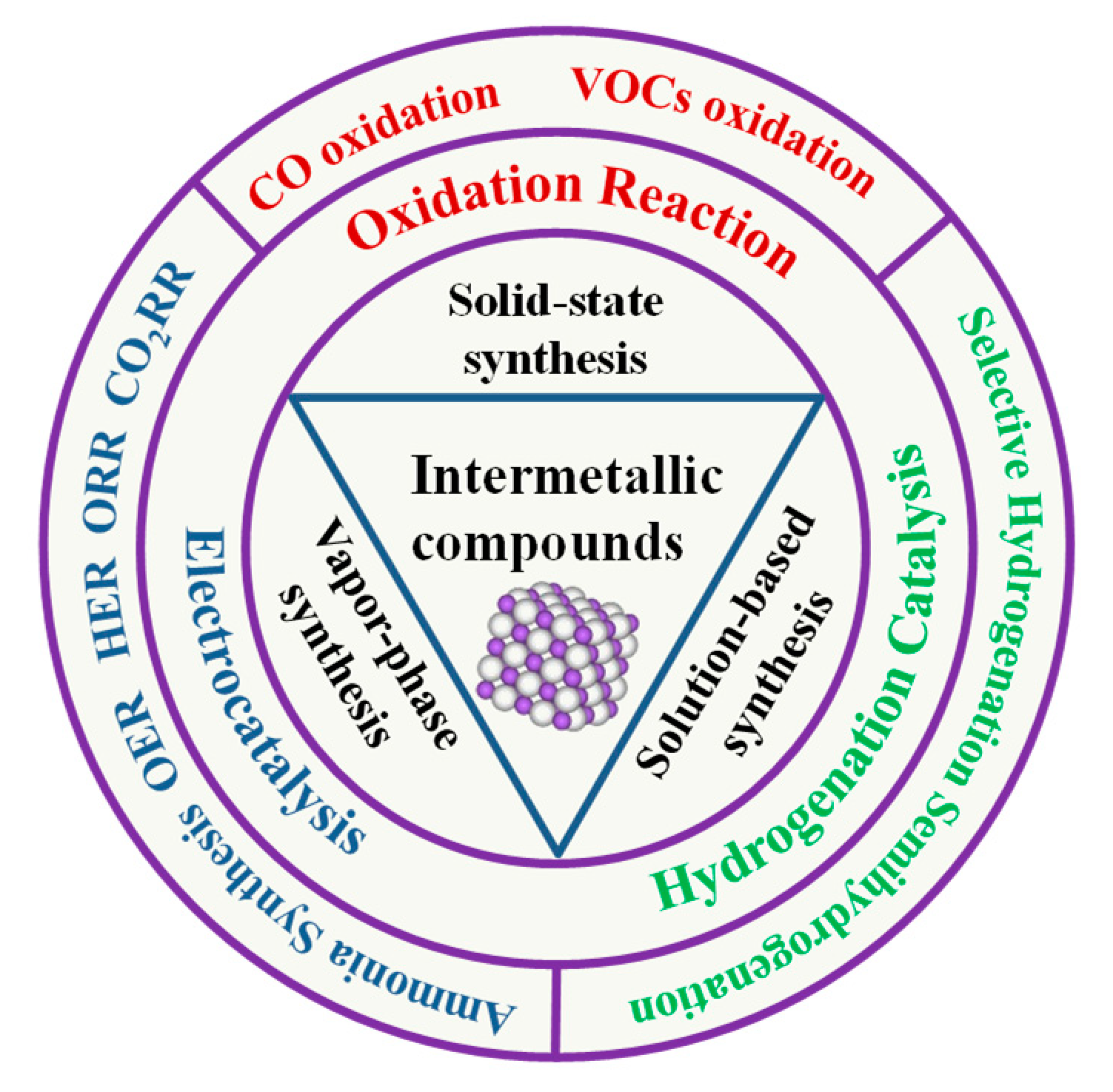
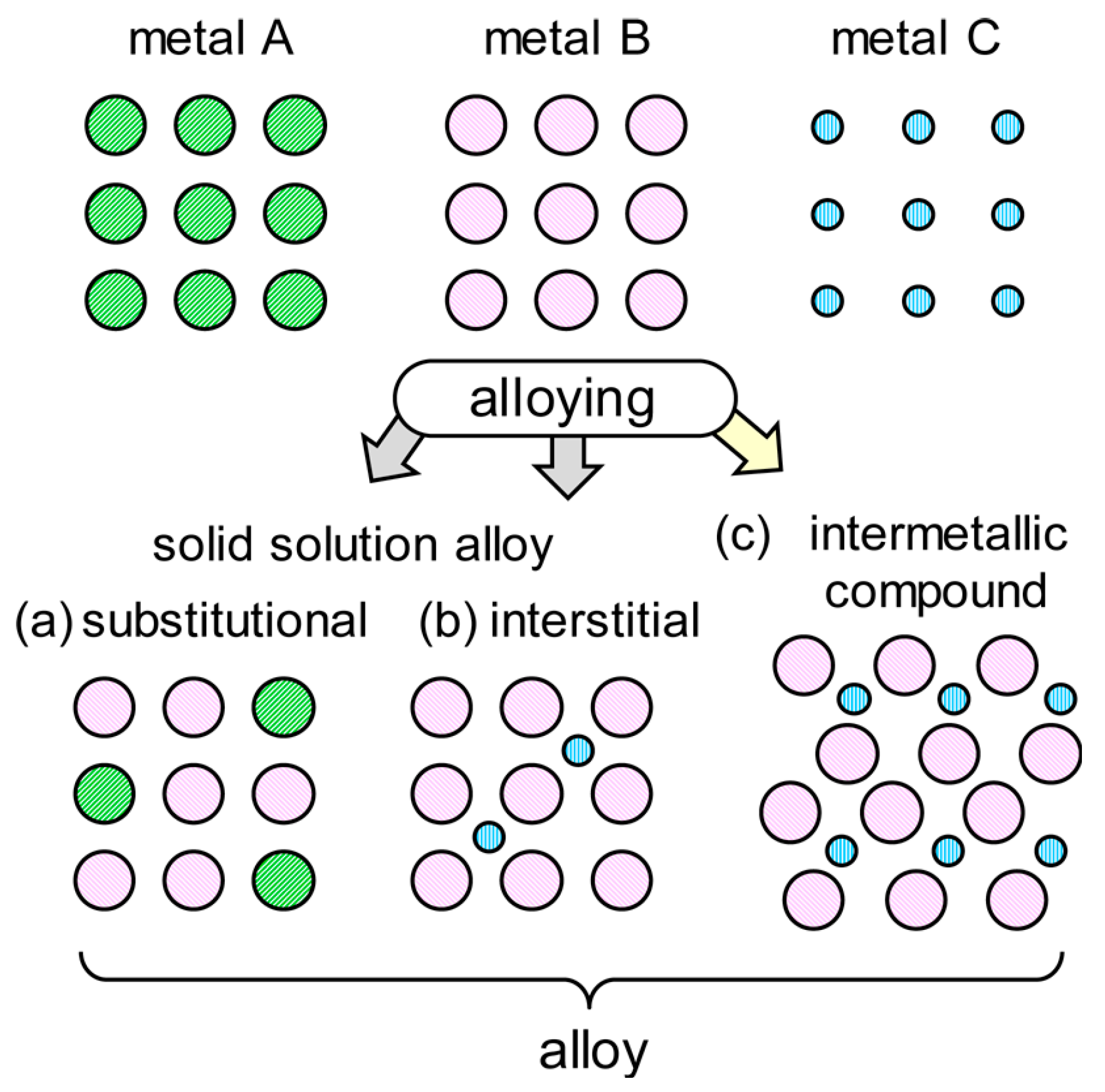
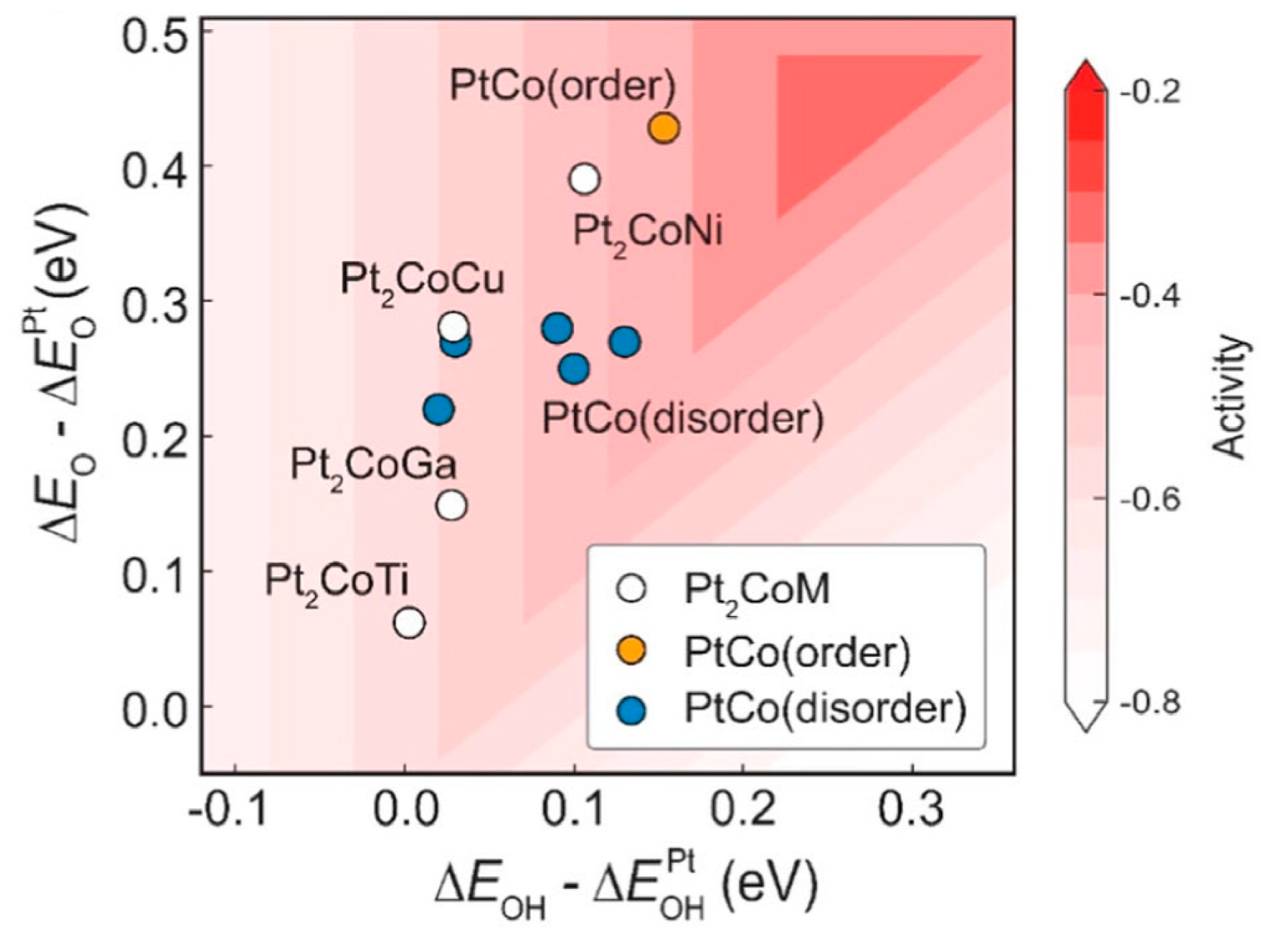


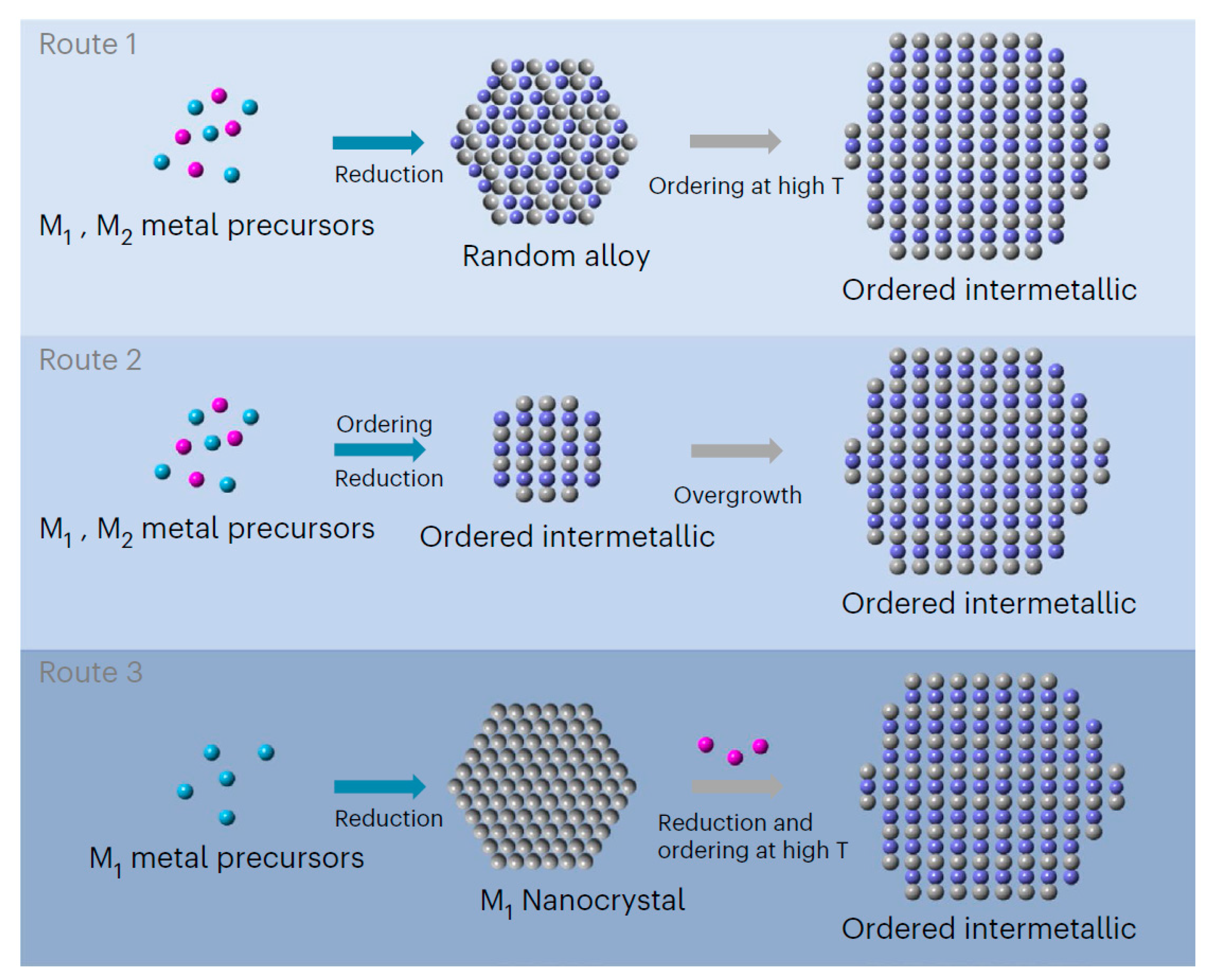
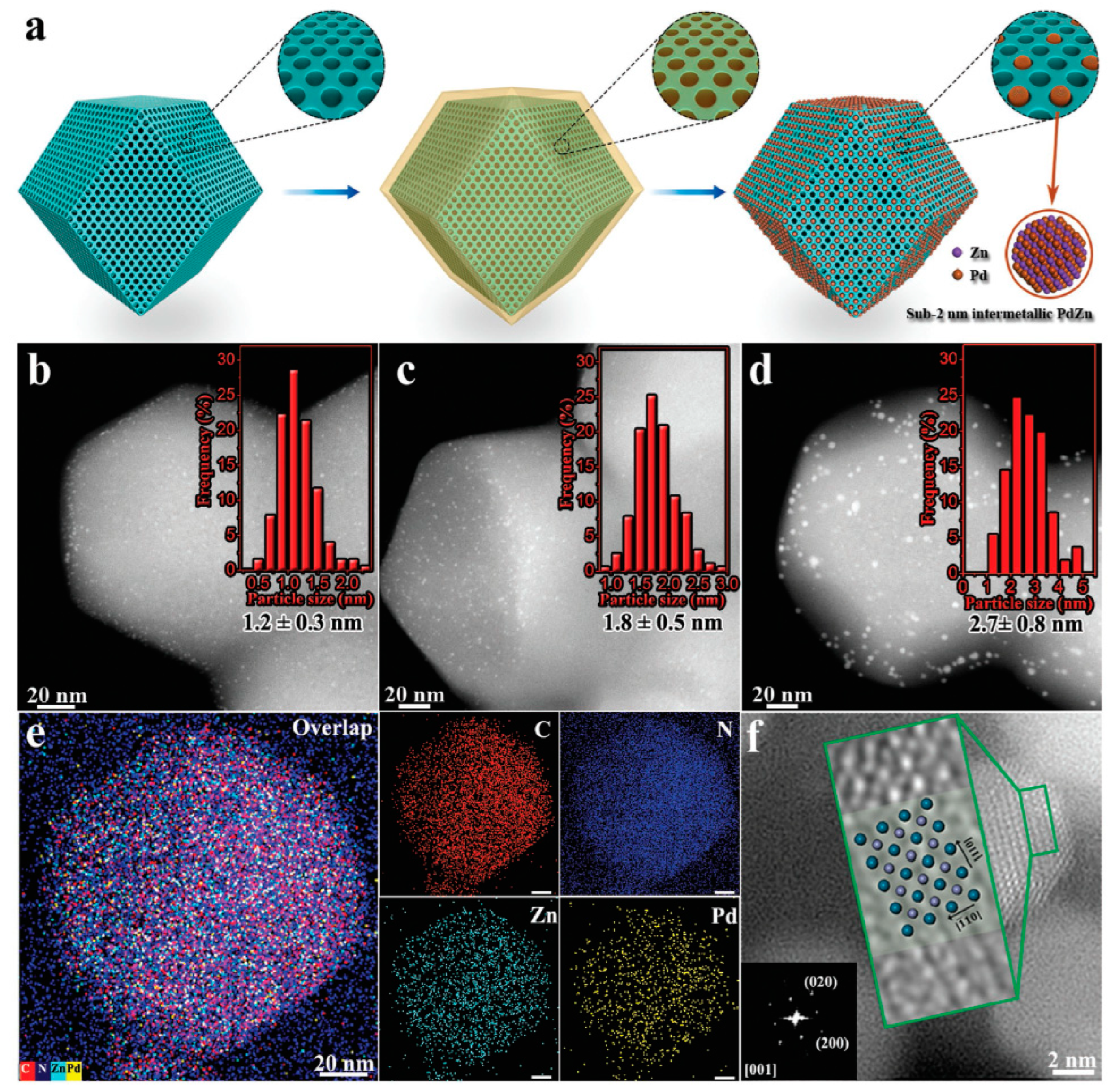

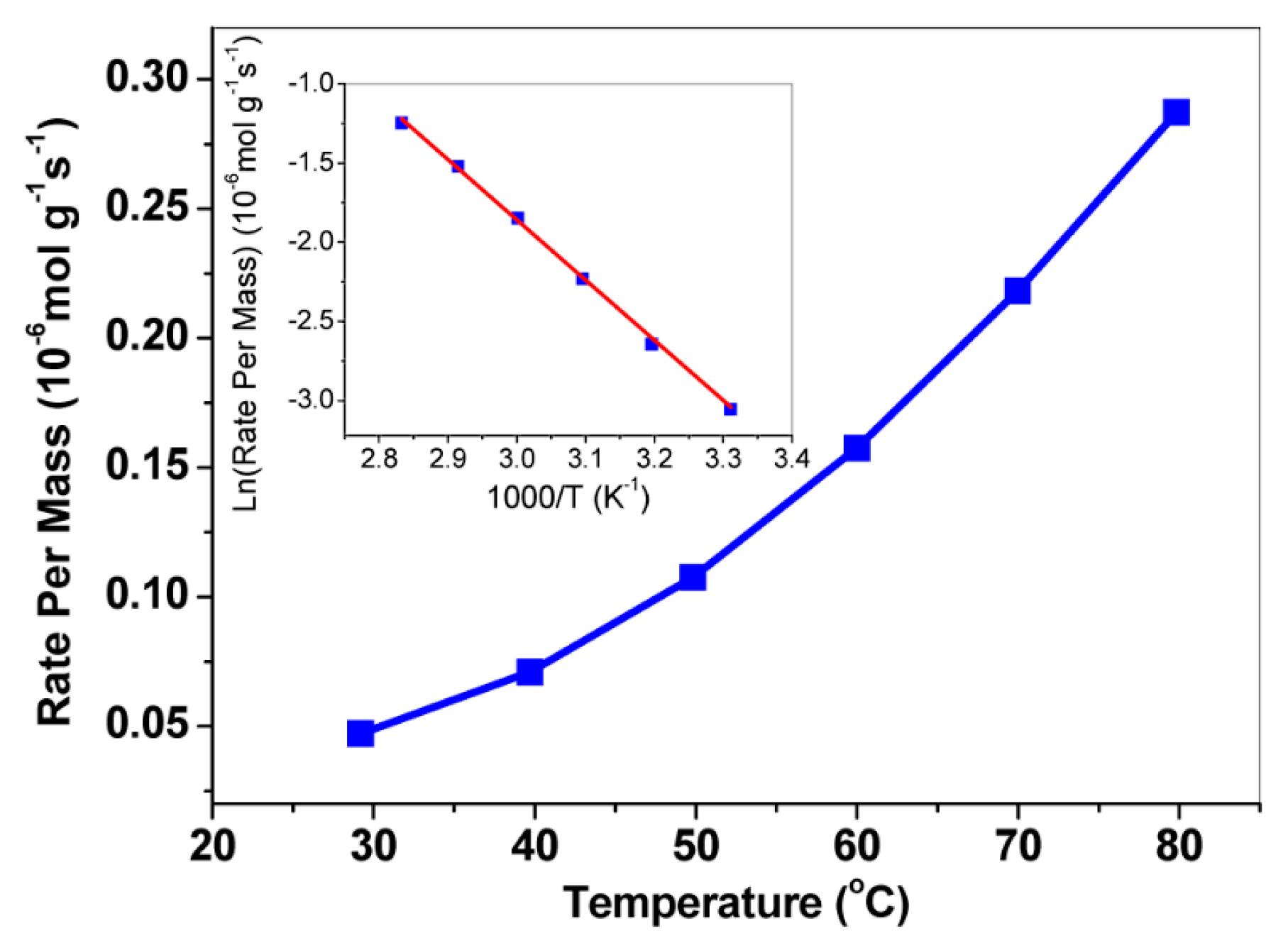
| Method | IMC | Catalytic Reaction | Reaction Condition | Catalytic Performance | Ref. |
|---|---|---|---|---|---|
| Chemical Reduction | PdxSny | Methanol oxidation reaction (MOR) | 1.0 M KOH; 1.0 M methanol; 50 mV/s | 1.3 A/mgPd or 5.03 mA/cm2 | [54] |
| M–Sn (M = Fe, Co, Ni, Pd) | – | – | – | [56] | |
| AuCu3 | – | – | – | [57] | |
| Annealing Reduction | PtCo | Oxygen reduction reaction (ORR) | 0.1 M HClO4; 0.15 mgPt/cm2; 10 mV/s | 863.2 mW/cm | [61] |
| PtFe/Pt | Oxygen reduction reaction (ORR) | 0.1 M HClO4; 0.054 mgPt/cm2; 10 mV/s | 0.92 A/mgPt | [62] | |
| Pt3Co | Oxygen reduction reaction (ORR) | 0.1 M HClO4; 0.06 mgPt/cm2; 50 mV/s Def-TiO2 | 5.1 mA/cmPt2 (0.85 V) | [63] | |
| PtSn, PtFe | Selective hydrogenation | CHD: nH2/nCH = 26 (250 °C); CPH: nH2/nCH = 29 (350 °C) | PtSn(1wt%)/CN-P: selectivity to UA (about 98%) | [64] | |
| Pt3Co | Preferential oxidation of CO | CO (2.0%), O2 (2.0%), H2 (35%), He (balance), 135 mL/min (0.05 g cat.) | T97% = 100 °C | [65] | |
| PdIn | Oxidative dehydrogenation of 1-butene and n-butane | 1-butene (12.5%); O2 (12.5%), and He balance) at 400 °C; 120 mL/min (0.05 g cat.) | 1,3-butadiene (10% yield, ~40% selectivity) | [67] | |
| Pt3Co | Oxygen reduction reaction (ORR) | 0.1 M HClO4; 0.01–0.018 mgPt/cm2; 50 mV/s Def-TiO2 | 1.3–1.8 A/mgPt (0.9 V) | [68] | |
| PdZn | Selective hydrogenation of acetylene | 0.65% acetylene, 5% hydrogen, 50.0% ethylene balanced with argon; 40 mL/min (0.05 g cat.) | specific rate: 0.049 mol/(h g) | [69] | |
| Pd2Ga/PdZn | Methanol synthesis and methanol steam reforming | 3:1 H2/CO2 mixture containing 4 vol% Ar; or molar ratio H2O/CH3OH = 1.0, 28.4% CH3OH; 100 mL/min (0.4 g cat.), T = 523 K | methanol synthesis: 0.51 /min (TOFMeOH) steam reforming of methanol: 61%(SCO2), 369 μmol/(min g) | [70] | |
| Chemical Vapor Deposition | PtFe | Oxygen reduction reaction (ORR) | 0.5 bar, H2/N2, 80 °C, 100% RH | 0.51 A/mgPt (0.94 V) | [72] |
| NiSix | Hydrogenation reactions | 80 °C, 3.0 MPa H2, 0.01 mol CMA | phenylacetylene to styrene (ca. 93%) | [73] | |
| Pt3Co, PtCu | Preferential oxidation of CO | CO (2.0%), O2 (1.0–2.0%), H2 (35%), and He (balance), 140 mL/min (0.05 g cat.) | T50 ≈ 90 °C | [74] | |
| Pt–Ge | hydrogenation of acetylene | C2H2 (14 kPa), H2 (29 kPa) and He (balance), 28 mL/min (0.02 g cat.) | 80% conversion, 60% selectivity to ethylene (473 K) | [75] | |
| Arc Melting Method | CeNi2 | CO hydrogenation | H2/CO = 2; CO = 33.6%, 1.5 m/min (0.5 g cat.) | ca. 5 μmol/(min m2) (260 °C) | [40] |
| PtFe, PtCo, PtNi | Oxygen reduction reaction (ORR) | 0.1 mol/L HClO4; 0.055 mgPt/cm2; 50 mV/s | 0.96 A/mgPt (0.9 V) | [46] |
Disclaimer/Publisher’s Note: The statements, opinions and data contained in all publications are solely those of the individual author(s) and contributor(s) and not of MDPI and/or the editor(s). MDPI and/or the editor(s) disclaim responsibility for any injury to people or property resulting from any ideas, methods, instructions or products referred to in the content. |
© 2024 by the authors. Licensee MDPI, Basel, Switzerland. This article is an open access article distributed under the terms and conditions of the Creative Commons Attribution (CC BY) license (https://creativecommons.org/licenses/by/4.0/).
Share and Cite
Hou, Z.; Hua, M.; Liu, Y.; Deng, J.; Zhou, X.; Feng, Y.; Li, Y.; Dai, H. Exploring Intermetallic Compounds: Properties and Applications in Catalysis. Catalysts 2024, 14, 538. https://doi.org/10.3390/catal14080538
Hou Z, Hua M, Liu Y, Deng J, Zhou X, Feng Y, Li Y, Dai H. Exploring Intermetallic Compounds: Properties and Applications in Catalysis. Catalysts. 2024; 14(8):538. https://doi.org/10.3390/catal14080538
Chicago/Turabian StyleHou, Zhiquan, Mengwei Hua, Yuxi Liu, Jiguang Deng, Xin Zhou, Ying Feng, Yifan Li, and Hongxing Dai. 2024. "Exploring Intermetallic Compounds: Properties and Applications in Catalysis" Catalysts 14, no. 8: 538. https://doi.org/10.3390/catal14080538
APA StyleHou, Z., Hua, M., Liu, Y., Deng, J., Zhou, X., Feng, Y., Li, Y., & Dai, H. (2024). Exploring Intermetallic Compounds: Properties and Applications in Catalysis. Catalysts, 14(8), 538. https://doi.org/10.3390/catal14080538








